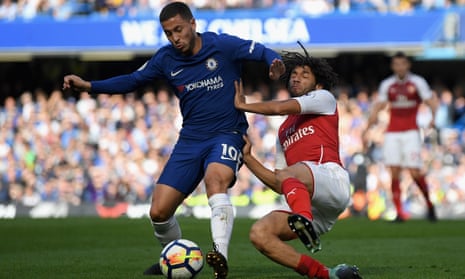On a rowdy, bruising, enjoyably intense afternoon at Stamford Bridge Chelsea showed two sides to their game. First came the one that doesn’t involve Eden Hazard. For the opening 70 minutes of this 0-0 draw the champions were neat, focused, disciplined and aggressively blunt in their attacking rhythms, the gears a little gummed.
After which, in glimpses, they played the other version, the Hazard-remix, the one where Chelsea’s No10 provides a vital free radical element in Antonio Conte’s hard-running 3-5-2, somebody to see the angles between the angles, to create space rather than simply applying relentless physical pressure.
Even with a convalescent Hazard on the pitch Chelsea looked not just more potent, but better balanced, a team with deeper gears, even a little champion swagger. At one point as the game ticked down Hazard dropped back, picked up the ball inside the Arsenal half and turned away from Olivier Giroud in a slightly mocking parabola, spinning through 180 degrees like a frigate evading a supertanker, showing in that moment the ability to beat an opponent almost as an afterthought that is beyond anybody else in this Chelsea team.
Not that there’s any great shame in that. Chelsea still came close to scoring several times in that opening hour . And Hazard is a genuinely rare presence in the Premier League, the obvious grace note in this hard-running collective, and a player without an obvious replacement in the squad.
Even before kick-off it was tempting to wonder where Chelsea might find a goal if Álvaro Morata was closely marked. Willian has three Premier League goals this year. Pedro has two since February. Victor Moses has not scored for Chelsea in the league since last November. N’Golo Kanté has two league goals in a season and a bit.
But then Conte’s champions have always been a linear, pared-back machine. Forty-eight of their 85 league goals last season were either scored or made by two players not on the pitch at the start here. Hazard, of course, but also the rogue Diego Costa, Arsenal’s own cackling, kidney‑jabbing nemesis who presumably watched this game on TV in Brazil in a state of unusual excitement, nipping out every few minutes to give his under‑gardener Chinese burns or rake his studs down the achilles of his sous-chef.
Chelsea started well here. With 10 minutes gone Morata should have scored, glancing a deep cross from César Azpilicueta wide. After which a strange thing happened. Arsenal began to dig in, to press recklessly high and match Chelsea not just in their formation, but in registers such as will, muscle and work rate. It took Conte to half-time to alter the balance of his Cesc Fàbregas-Kanté pivot in central midfield. For all his incision Fàbregas has been a stretch as a pure central midfielder ever since he came to the club. Here it was one of those days where too many battles are lost, too much ground conceded.
In the second half Chelsea were stronger, Tiémoué Bakayoko coming on and almost immediately picking up the ball and driving through the middle of the pitch, all strolling power and balance. Still, though, in a tight game what Chelsea really lacked was a moment of stillness.
The game-plan often seems to involve playing tight, high-pressure football and waiting for a mistake, which is let’s face it never the worst idea against late‑Wenger Arsenal. The parts continued to function well here. Now and then Marcos Alonso would spank a hard, flat pass 50 metres to Moses on the other wing. Willian and Pedro sprinted with verve through the channels and Conte became increasingly animated on his touchline as the game began to congeal a little.
Hazard’s appearance did open up that attacking third eye a little, a player who simply looks different to everyone else, lower to the ground, able to take the ball on the half-turn and pick up speed instantly. Three or four times there were moments of muscle-memory recall as Hazard ran at Arsenal’s defence with the old preternatural balance, feet battering the turf in double-time.
His return will of course be vital to Chelsea’s progress from here. For the last three seasons Chelsea have had two players to wrench days like this their way. Morata is a variation on Costa, but not in any sense a replacement for his horrible, match-turning voodoo. Morata looked like a player finding his space in this team, spending most of the time falling over to no great effect.
Similarly there is no real Hazard-alternative in this squad. Chelsea were linked with plenty of refusenik transfer targets this summer but none that would have really changed the way the team plays, or offered a different set of attacking rhythms. Conte seems to want two Chelsea teams that will play the same way. If this claustrophobic game of fine details revealed anything it is that he is perhaps missing another note of flair and uncontrolled creativity to slot in on days like this.

